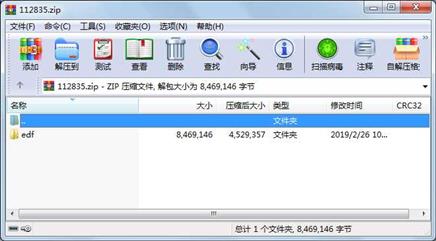资源简介
支持.edf文件的读取与解析,内附使用测试,运行test.m文件即可

代码片段和文件信息
function [hdr record] = edfread(fname varargin)
% Read European Data Format file into MATLAB
%
% [hdr record] = edfread(fname)
% Reads data from ALL RECORDS of file fname (‘*.edf‘). Header
% information is returned in structure hdr and the signals
% (waveforms) are returned in structure record with waveforms
% associated with the records returned as fields titled ‘data‘ of
% structure record.
%
% [...] = edfread(fname ‘assignToVariables‘ assignToVariables)
% Triggers writing of individual output variables as defined by
% field ‘labels‘ into the caller workspace.
%
% [...] = edfread(...‘desiredSignals‘desiredSignals)
% Allows user to specify the names (or position numbers) of the
% subset of signals to be read. |desiredSignals| may be either a
% string a cell array of comma-separated strings or a vector of
% numbers. (Default behavior is to read all signals.)
% E.g.:
% data = edfread(mydata.edf‘desiredSignals‘‘Thoracic‘);
% data = edfread(mydata.edf‘desiredSignals‘{‘Thoracic1‘‘Abdominal‘});
% or
% data = edfread(mydata.edf‘desiredSignals‘[246:13]);
%
% FORMAT SPEC: Source: http://www.edfplus.info/specs/edf.html SEE ALSO:
% http://www.dpmi.tu-graz.ac.at/~schloegl/matlab/eeg/edf_spec.htm
%
% The first 256 bytes of the header record specify the version number of
% this format local patient and recording identification time information
% about the recording the number of data records and finally the number of
% signals (ns) in each data record. Then for each signal another 256 bytes
% follow in the header record each specifying the type of signal (e.g.
% EEG body temperature etc.) amplitude calibration and the number of
% samples in each data record (from which the sampling frequency can be
% derived since the duration of a data record is also known). In this way
% the format allows for different gains and sampling frequencies for each
% signal. The header record contains 256 + (ns * 256) bytes.
%
% Following the header record each of the subsequent data records contains
% ‘duration‘ seconds of ‘ns‘ signals with each signal being represented by
% the specified (in the header) number of samples. In order to reduce data
% size and adapt to commonly used software for acquisition processing and
% graphical display of polygraphic signals each sample value is
% represented as a 2-byte integer in 2‘s complement format. Figure 1 shows
% the detailed format of each data record.
%
% DATA SOURCE: Signals of various types (including the sample signal used
% below) are available from PHYSIONET: http://www.physionet.org/
%
%
% % EXAMPLE 1:
% % Read all waveforms/data associated with file ‘ecgca998.edf‘:
%
% [header recorddata] = edfRead(‘ecgca998.edf‘);
%
% % EXAMPLE 2:
% % Read records 3 and 5 associated with file ‘ecgca998.edf‘:
%
% header = ed 属性 大小 日期 时间 名称
----------- --------- ---------- ----- ----
文件 8455680 2019-02-26 10:39 edf\Affaaf.edf
文件 10388 2019-02-26 10:48 edf\edfread.m
文件 3038 2017-06-06 12:40 edf\readedf.m
文件 40 2019-02-26 10:52 edf\test.m
目录 0 2019-02-26 10:48 edf\
相关资源
- 编程实现二维DCT变换
- 图像二值化
- 用FFT对信号进行频谱分析
- Tone-Reservation
- QGA 量子遗传算法
- 差分形式的阻滞增长模型
- 遗传算法的M文件
- 简单二阶互联系统的非线性动力学分
- 手写数字识别-模板匹配法
- Stock_Watson_动态因子分析模型
- 果蝇优化算法优化支持向量回归程序
- 自己做的一个简单GUI扑克纸牌识别-
- multi output SVR
- AR过程的线性建模过程与各种功率谱估
- PCNN TOOLBOX
- plstoolbox.zip
- 中国国家基础地理信息系统GIS数据
- 粒子群微电网优化调度
- 矩阵分析-经典教材-中文版-Roger.A.Ho
- 压缩感知TwIST
- 基于最小错误率的贝叶斯手写数字分
- 最全系统辨识源代码,包括多种最小
- 导弹制导实验
- 画跟踪精确度图的程序.zip
- 重力场大地水准面及重力异常阶次误
- prtools5.2.3工具包
- 脉冲耦合神经网络工具箱PCNN-toolbox
- SVM算法-回归拟合程序.zip
- Kriging代理模型EGO算法.zip
- Matalb实现停车场完整系统
 川公网安备 51152502000135号
川公网安备 51152502000135号
评论
共有 条评论